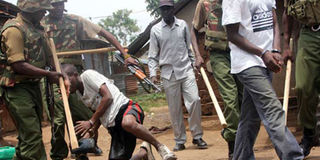Police must change approach or protests will only increase

Anti-riot police detain a man during a protest against the Independent Electoral and Boundaries Commission in Nakuru on May 23, 2016 in Nakuru. PHOTO | SULEIMAN MBATIAH | NATION MEDIA GROUP
What you need to know:
For some reason, police responses to protests have been inevitably sharper and more aggressive than other protests organised by whites or other groups: they come out in larger numbers, in more aggressive formations, including riot and militarised gear, complete with helicopters flying overhead to drown out the chants and words of the leaders.
The effect of this discriminatory approach has been more overt support at BLM protests from white activists and supporters.
We have seen similar discriminatory responses by our police with protests in Kisumu and other Luo-dominant areas such as Kibra, Nairobi. And just like with BLM, the intent to intimidate and weaken only leads to more determination and anger.
America has recently been in the grip of fervent, angry protests organised by the Black Lives Matter (BLM) movement, which started in 2013, following the acquittal of George Zimmerman, who had been accused of killing black teenager Trayvon Martin. Since then, the movement has morphed and grown and has been at the heart of most protests organised by African Americans against police killings and brutality, racial inequality and the racism of a criminal justice system that has resulted in one in six black men incarcerated since 2001.
While the BLM movement has generated tremendous support within the black community, it has created unease, especially within parts of the white community that controls power. Some think that BLM seeks preferential treatment, over and above other communities. But, actually all BLM desires is that black lives be protected and revered the same as other lives, rather than be seen as dispensable. They demand that the devaluation of black lives—from slavery, through the Jim Crow laws that institutionalised segregation and marginalisation, and then through the “War on Drugs” that disproportionately targets black lives—must stop.
Consider this: in 2015, only 10 of 102 cases of killings of unarmed black men by police officers resulted in charges against the officers, and in only two of the deaths were officers convicted. Now, it can’t be that in all the other 102 cases the officers were innocent and had proper justification to kill. But the legal system is so weighted in favour of the police that if they assert that they thought they were under threat, they will often get acquitted.
ACROSS US
So BLM has protested and marched across almost all of the US. There have been some massive protests, but also some small ones. And through it all, they have captured the attention of the country, with lots of support from other communities, which has helped popularise their issues. But there has also been resistance, especially from the police and their allies.
In fact, the police, who as the primary actors on the ground are a target of BLM protests, have generally been hostile to the movement. They have insinuated that BLM is the reason for the targeted shootings of police officers, blaming the BLM for “creating” animosity against police. BLM’s response is that they are a non-violent movement, and the animosity against the police has been simmering deeply for decades, and all BLM has done is to give those views an outlet. In fact, in BLM views, it should be the police reaching out to black communities to seek reconciliation and common cause, for it is them that have been on the frontline in devaluing black lives. To be sure, this reaching out and doing policing differently is on the rise in cities such as Jackson, Mississippi where there is consensus that the police chief cares for the community and has prioritised working closely with the communities as opposed to antagonising them, while doing crime prevention and detection efficiently.
The Kenyans who have laboured for decades trying to hold our police accountable for their massive excesses can relate to this. There is a fundamental problem with police forces in many countries across the world: they have so much power and leeway that they often do what they want, knowing they can get away with it. In a country like Kenya, it is easier for them to escape accountability because even holding peaceful protests often attracts police violence, despite our constitutional right to assemble under Article 37.
For some reason, police responses to protests have been inevitably sharper and more aggressive than other protests organised by whites or other groups: they come out in larger numbers, in more aggressive formations, including riot and militarised gear, complete with helicopters flying overhead to drown out the chants and words of the leaders. The effect of this discriminatory approach has been more overt support at BLM protests from white activists and supporters!
We have seen similar discriminatory responses by our police with protests in Kisumu and other Luo-dominant areas such as Kibra, Nairobi. And just like with BLM, the intent to intimidate and weaken only leads to more determination and anger.





